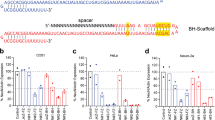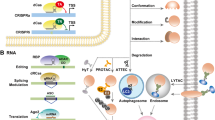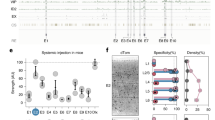Abstract
Conditional mutant techniques that allow spatial and temporal control over gene expression can be used to create mice with restricted genetic modifications. These mice serve as powerful disease models in which gene function in adult tissues can be specifically dissected. Current strategies for conditional genetic manipulation are inefficient, however, and often lack sufficient spatial control. Here we use viral-mediated RNA interference (RNAi) to generate a specific knockdown of Th, the gene encoding the dopamine synthesis enzyme tyrosine hydroxylase, within midbrain neurons of adult mice. This localized gene knockdown resulted in behavioral changes, including a motor performance deficit and reduced response to a psychostimulant. These results underscore the potential of using viral-mediated RNAi for the rapid production and testing of new genetic disease models. Similar strategies may be used in other model species, and may ultimately find applications in human gene therapy.
This is a preview of subscription content, access via your institution
Access options
Subscribe to this journal
Receive 12 print issues and online access
$209.00 per year
only $17.42 per issue
Buy this article
- Purchase on Springer Link
- Instant access to full article PDF
Prices may be subject to local taxes which are calculated during checkout





Similar content being viewed by others
References
Lewandoski, M. Conditional control of gene expression in the mouse. Nat. Rev. Genet. 2, 743–755 (2001).
Gossen, M. & Bujard, H. Studying gene function in eukaryotes by conditional gene inactivation. Annu. Rev. Genet. 36, 153–173 (2002).
DiLeone, R.J., Russell, L.B. & Kingsley, D.M. An extensive 3′ regulatory region controls expression of Bmp5 in specific anatomical structures of the mouse embryo. Genetics 148, 401–408 (1998).
Fire, A. et al. Potent and specific genetic interference by double-stranded RNA in Caenorhabditis elegans. Nature 391, 806–811 (1998).
Fraser, A.G. et al. Functional genomic analysis of C. elegans chromosome I by systematic RNA interference. Nature 408, 325–330 (2000).
Lum, L. et al. Identification of Hedgehog pathway components by RNAi in Drosophila cultured cells. Science 299, 2039–2045 (2003).
Kennerdell, J.R. & Carthew, R.W. Heritable gene silencing in Drosophila using double-stranded RNA. Nat. Biotechnol. 18, 896–898 (2000).
Kalidas, S. & Smith, D.P. Novel genomic cDNA hybrids produce effective RNA interference in adult Drosophila. Neuron 33, 177–184 (2002).
Elbashir, S.M. et al. Duplexes of 21-nucleotide RNAs mediate RNA interference in cultured mammalian cells. Nature 411, 494–498 (2001).
Yu, J.Y., DeRuiter, S.L. & Turner, D.L. RNA interference by expression of short-interfering RNAs and hairpin RNAs in mammalian cells. Proc. Natl. Acad. Sci. USA 99, 6047–6052 (2002).
Krichevsky, A.M. & Kosik, K.S. RNAi functions in cultured mammalian neurons. Proc. Natl. Acad. Sci. USA 99, 11926–11929 (2002).
McCaffrey, A.P. et al. RNA interference in adult mice. Nature 418, 38–39 (2002).
Xia, H., Mao, Q., Paulson, H.L. & Davidson, B.L. siRNA-mediated gene silencing in vitro and in vivo. Nat. Biotechnol. 20, 1006–1010 (2002).
McCown, T.J., Xiao, X., Li, J., Breese, G.R. & Samulski, R.J. Differential and persistent expression patterns of CNS gene transfer by an adeno-associated virus (AAV) vector. Brain Res. 713, 99–107 (1996).
Chamberlin, N.L., Du, B., de Lacalle, S. & Saper, C.B. Recombinant adeno-associated virus vector: use for transgene expression and anterograde tract tracing in the CNS. Brain Res. 793, 169–175 (1998).
McGeer, E.G., McGeer, P.L. & Wada, J.A. Distribution of tyrosine hydroxylase in human and animal brain. J. Neurochem. 18, 1647–1658 (1971).
Han, V.K., Snouweart, J., Towle, A.C., Lund, P.K. & Lauder, J.M. Cellular localization of tyrosine hydroxylase mRNA and its regulation in the rat adrenal medulla and brain by in situ hybridization with an oligodeoxyribonucleotide probe. J. Neurosci. Res. 17, 11–18 (1987).
Koob, G.F. & Nestler, E.J. The neurobiology of drug addiction. J. Neuropsychiatry Clin. Neurosci. 9, 482–497 (1997).
Berridge, K.C. & Robinson, T.E. What is the role of dopamine in reward: hedonic impact, reward learning, or incentive salience? Brain Res. Brain Res. Rev. 28, 309–369 (1998).
Zhou, Q.Y. & Palmiter, R.D. Dopamine-deficient mice are severely hypoactive, adipsic, and aphagic. Cell 83, 1197–1209 (1995).
Gibb, W.R. Functional neuropathology in Parkinson's disease. Eur. Neurol. 38 (suppl. 2), 21–50 (1997).
Chuang, D., Zsilla, G. & Costa, E. Turnover rate of tyrosine hydroxylase during trans-synaptic induction. Mol. Pharmacol. 11, 784–794 (1975).
Moore, K.E. The actions of amphetamine on neurotransmitters: a brief review. Biol. Psychiatry 12, 451–462 (1977).
Colotla, V.A., Flores, E., Oscos, A., Meneses, A. & Tapia, R. Effects of MPTP on locomotor activity in mice. Neurotoxicol. Teratol. 12, 405–407 (1990).
Rozas, G., Lopez-Martin, E., Guerra, M.J. & Labandeira-Garcia, J.L. The overall rod performance test in the MPTP-treated-mouse model of Parkinsonism. J. Neurosci. Methods 83, 165–175 (1998).
Tiscornia, G., Singer, O., Ikawa, M. & Verma, I.M. A general method for gene knockdown in mice by using lentiviral vectors expressing small interfering RNA. Proc. Natl. Acad. Sci. USA 100, 1844–1848 (2003).
Fitzsimons, H.L., McKenzie, J.M. & During, M.J. Insulators coupled to a minimal bidirectional tet cassette for tight regulation of rAAV-mediated gene transfer in the mammalian brain. Gene Ther. 8, 1675–1681 (2001).
Yu, J.Y., Taylor, J., DeRuiter, S.L., Vojtek, A.B. & Turner, D.L. Simultaneous inhibition of GSK3α and GSK3β using hairpin siRNA expression vectors. Mol. Ther. 7, 228–236 (2003).
Girod, A. et al. Genetic capsid modifications allow efficient re-targeting of adeno-associated virus type 2. Nat. Med. 5, 1052–1056 (1999).
Zhou, Q.Y., Quaife, C.J. & Palmiter, R.D. Targeted disruption of the tyrosine hydroxylase gene reveals that catecholamines are required for mouse fetal development. Nature 374, 640–643 (1995).
Polymeropoulos, M.H. et al. Mutation in the α-synuclein gene identified in families with Parkinson's disease. Science 276, 2045–2047 (1997).
Kitada, T. et al. Mutations in the parkin gene cause autosomal recessive juvenile parkinsonism. Nature 392, 605–608 (1998).
Manno, C.S. et al. AAV-mediated factor IX gene transfer to skeletal muscle in patients with severe hemophilia B. Blood 101, 2963–2972 (2003).
Zolotukhin, S. et al. Recombinant adeno-associated virus purification using novel methods improves infectious titer and yield. Gene Ther. 6, 973–985 (1999).
Georgescu, D. et al. Involvement of the lateral hypothalamic peptide orexin in morphine dependence and withdrawal. J. Neurosci. 23, 3106–3111 (2003).
Paxinos, G. & Franklin, K.B.J. The mouse brain in stereotaxic coordinates (Academic Press, New York, 2000).
Acknowledgements
We thank D. Turner for providing the U6 promoter-containing vector, L. Perrotti for rotarod assay protocols, E. Kim and L. Leverich for help with data collection, and C. Bolaños for advice on data analysis.
Author information
Authors and Affiliations
Corresponding author
Ethics declarations
Competing interests
The authors declare no competing financial interests.
Supplementary information
Rights and permissions
About this article
Cite this article
Hommel, J., Sears, R., Georgescu, D. et al. Local gene knockdown in the brain using viral-mediated RNA interference. Nat Med 9, 1539–1544 (2003). https://doi.org/10.1038/nm964
Received:
Accepted:
Published:
Issue Date:
DOI: https://doi.org/10.1038/nm964
This article is cited by
-
Role of neuropeptide neuromedin U in the nucleus accumbens shell in cocaine self-administration in male rats
Neuropsychopharmacology (2022)
-
Corticostriatal stimulation compensates for medial frontal inactivation during interval timing
Scientific Reports (2019)
-
Mechanical strain promotes skin fibrosis through LRG-1 induction mediated by ELK1 and ERK signalling
Communications Biology (2019)
-
Osteocalcin in the brain: from embryonic development to age-related decline in cognition
Nature Reviews Endocrinology (2018)
-
Stimulation of entorhinal cortex–dentate gyrus circuitry is antidepressive
Nature Medicine (2018)



